

 |
 |
The Value of a Ten
The so-called Standard American point count system —
devised by Milton Work in contract bridge's formative years —
has proved immensely popular if only for its utter simplicity. Although
Ely Culbertson's Honor-Trick Table was considered de rigeur
in the 1930s, counting all those half-tricks and quarter-tricks
was tedious — and largely inaccurate. In 1936, Charles Goren
began developing and popularizing a point-count method in his own books,
which instigated a 15-year battle between those titans of bridge.
Because the new 4.3.2.1 valuation scheme was much
easier on the brain and more accurate as well, it ultimately supplanted the
old system and remains the favorite some eight decades later.
The old Honor-Trick table overvalued kings and A-K combinations, much to
the dismay of countless declarers going set in notrump contracts that should
have been fulfilled according to their charts. Conversely, today's expert
consensus is that the higher honors are undervalued by the 4.3.2.1
count. New valuations have been suggested for the ace, king, queen, and
jack. For example, one programmer's research on balanced hands suggests
a rating system of 6½-4½-2½-1. Some players
add ½ point for a ten or other plus-value.
Advanced players will further upgrade or downgrade certain holdings based upon
suit-lengths, honor-combinations, and spot-cards.
Experimentation with new evaluations is partially stymied, however, by the
tunnel-visioned ACBL, which laws mandate that certain bidding agreements,
such as the ranges for an opening One-Trump or Weak-Two-Bid, conform
to Work-Points only.
In any case, I believe that sufficiently comprehensive simulations could
establish a more accurate numeric ratio among the honors, by comparing their
frequencies of occurrence with double-dummy trick totals over a great
number of deals. Although this seems like a straightforward analysis,
I have seen no such results published as yet. SIM
will get the ball rolling here.

Today's spotlight is on the "forgotten honor" — the lowly
TEN. Oh sure — every player talks about
having "good fillers" or "no spots" or the like, but the
common quick-evaluation methods make no accommodation for other than the
top four honors. This oversight is a significant error, as the following
data show.
For this simulation, North and South were dealt 13 hcp each.
Four different hand-pattern combinations are compared. For added
interest (and because the feature is built into SIM),
each scenario arbitrarily compares the results of a contract of
1NT with a game bid of 3NT.
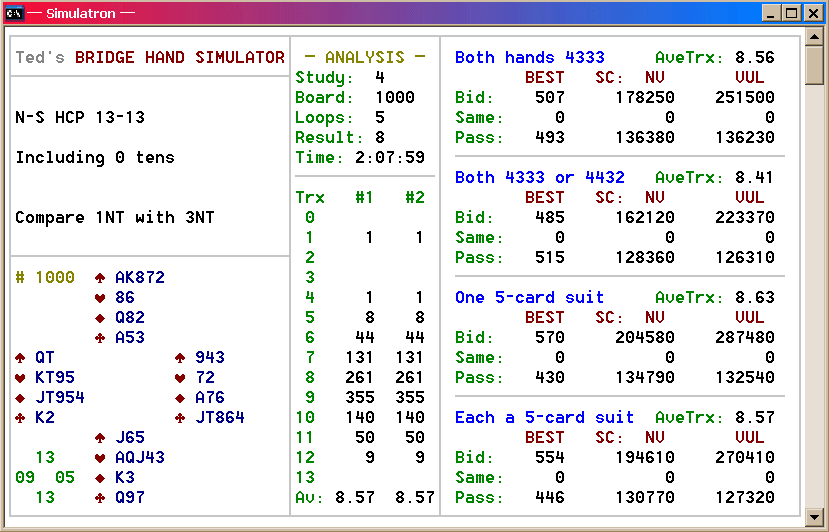
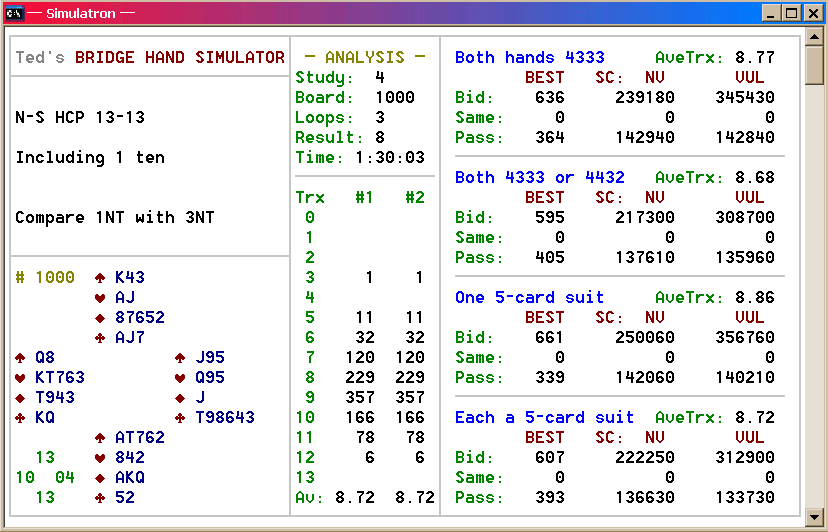
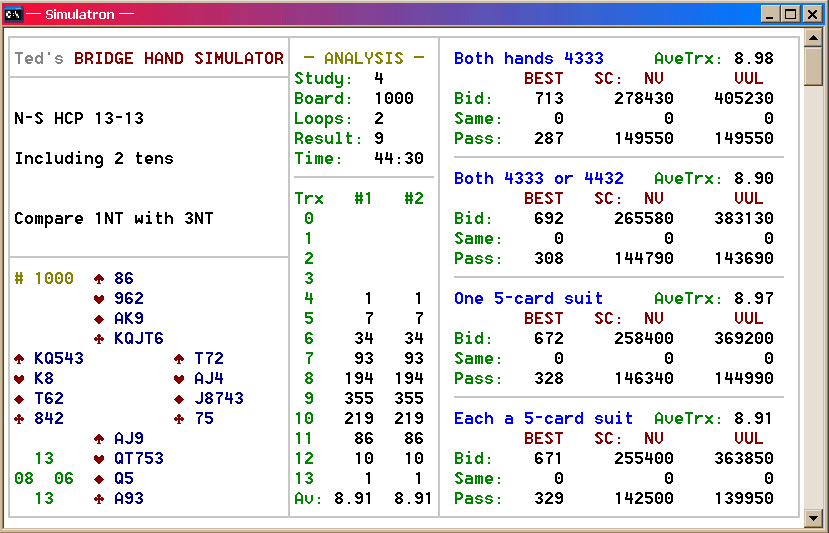
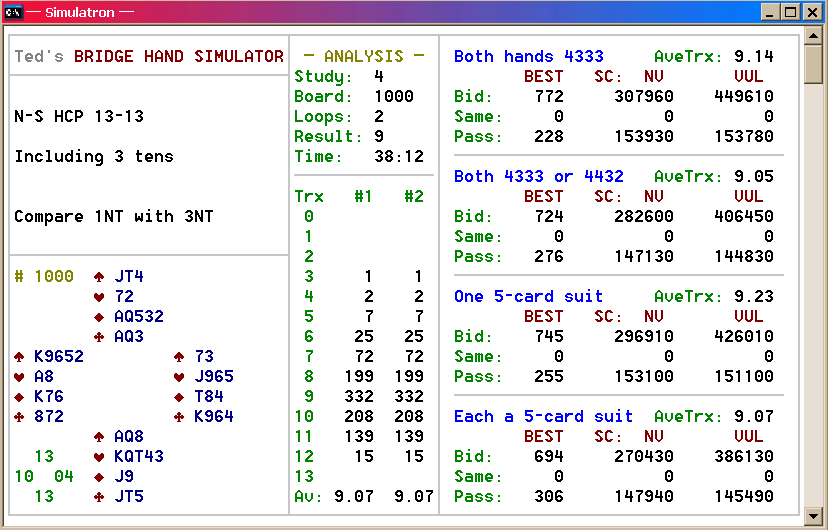
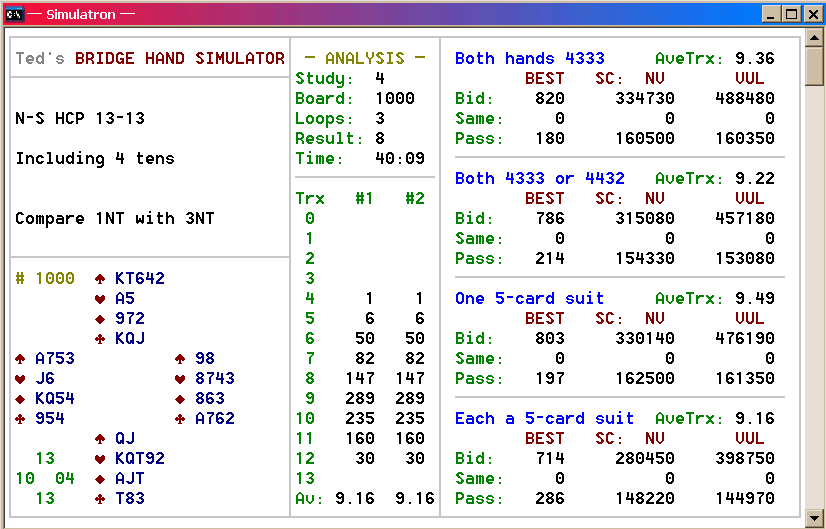
So! It seems that the presence of tens can be worth quite a bit.
Note from the Bid/Pass data that with two 'spotless'
hands, game is made barely half the time despite the 26-hcp
total; yet nearly 80% of the ten-rich games succeed.
Let's compress the trick data for readability:
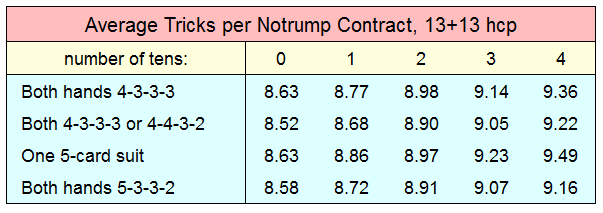
Fascinating! Although the actual increments between boxes vary
somewhat due to the relatively small sampling of these studies (1,000
deals each), the tendencies are clear: possession of supporting
ten-spots is a big deal.
The difference between having no ten and possessing them all
is approximately .6 to .8 tricks, which translates roughly to
one-sixth of a trick per card. On average,
the offensive side will possess nearly half of the ten-spots anyway;
but when all are working together, that's an additional trick on every
third hand that you play. Those tricks score up a lot of extra game
and slam bonuses.

In terms of total points, the numbers are equally astounding.
This chart condenses the total-point expectations,
assuming that game is bid on every hand:

Wow! It seems that a ten is worth
approximately 13 points non-vulnerable, and about 20 points when
vulnerable. The ten-rich hands generate fully 70-80%
more total points than their substance-bereft counterparts!
Compared to the average holding of a pair of tens, having all four is worth
about 20% additional total points.

The bottom line: Within our test framework of balanced hands with
13 × 13 hcp,
** Each ten is worth roughly 1/6
of a trick.
** Each ten adds an average of 10-15% to the final trick-score!
Translating a ten's worth into a meaningful equivalent
high-card-point value is more difficult, but eventually
SIM will determine
The Way It Is. The merits of lesser
spot-cards might be examined as well.

Note from the graphs that the hands with opposing 4-3-3-3
patterns fared better than when 4-4-3-2 patterns were included.
Why? Also, declarers with but a single 5-card
suit to work with handily out-scored those in which both hands had a
5-card suit. Why? That seems non-intuitive,
and the literature offers little if any insight into this phenomenon.
I believe, however, that SIM already has suggested
the answer — to be detailed in an upcoming study.